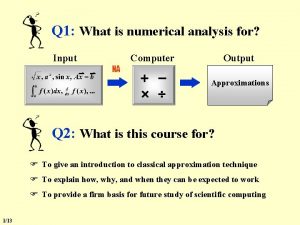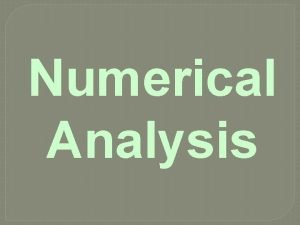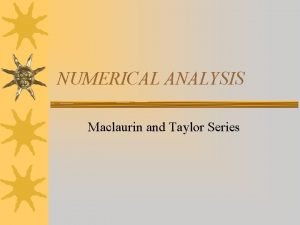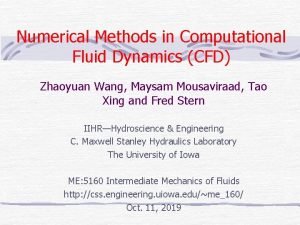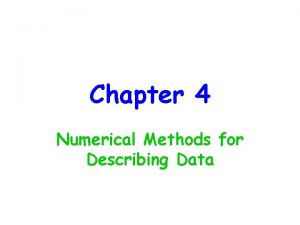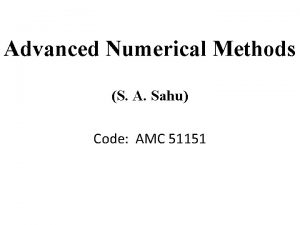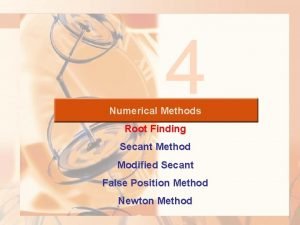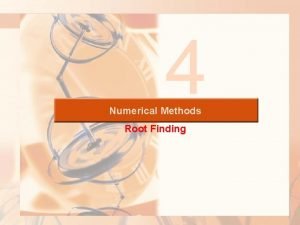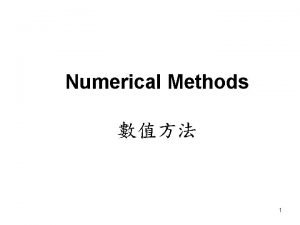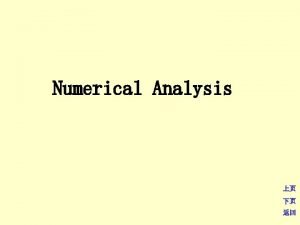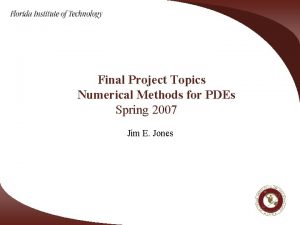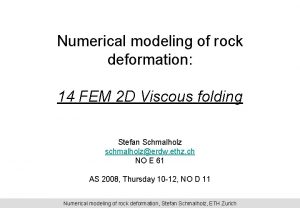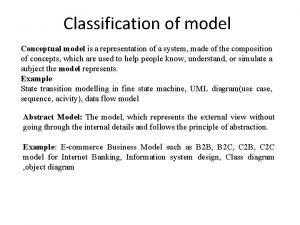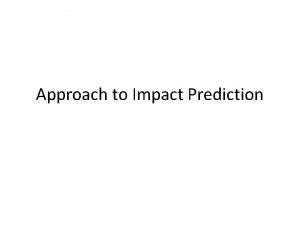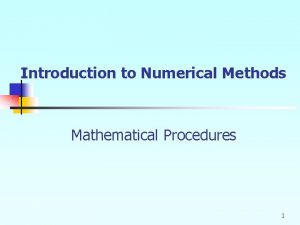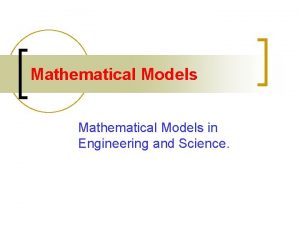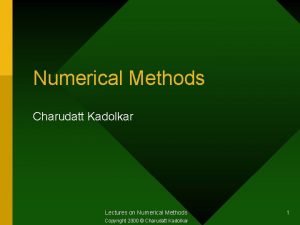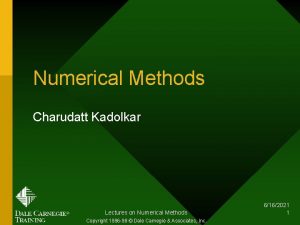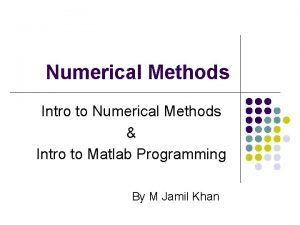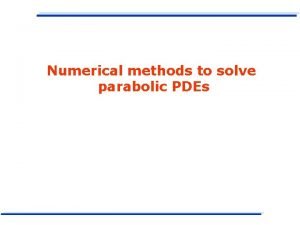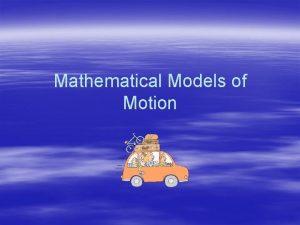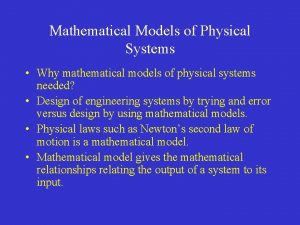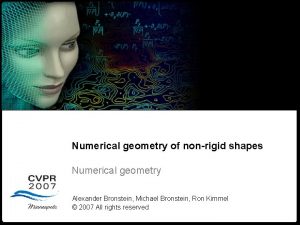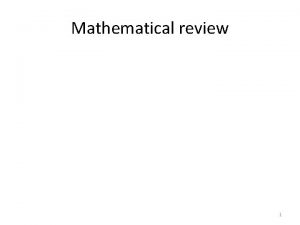VIII Conference Mathematical Models and Numerical Methods in












![Validation Common carotid artery [ml/sec] Descending Aorta ᵟ =11, 6% [cm/s] ᵟ =16, 4% Validation Common carotid artery [ml/sec] Descending Aorta ᵟ =11, 6% [cm/s] ᵟ =16, 4%](https://slidetodoc.com/presentation_image_h/36cbf8243e4f435cb2af35cb2a53371d/image-13.jpg)
![Mass balance control [Volume, L] Pseudo stationary flow development Time, seconds 14 Mass balance control [Volume, L] Pseudo stationary flow development Time, seconds 14](https://slidetodoc.com/presentation_image_h/36cbf8243e4f435cb2af35cb2a53371d/image-14.jpg)






- Slides: 20

VIII Conference “Mathematical Models and Numerical Methods in Biomathematics” Computational model of two-phase transport of transmembrane peptides by blood flow Y. N. Soe Moscow Institute of Physics and Technology Under supervision of S. S. Simakov INM RAS, 03. 11 2016 1

q. Motivation q. Blood flow model q. Two-Phase Transport Model q. Results 2

Motivation Some drugs cause toxic systemic side-effects. Administration and delivery of these drugs should be efficient and targeted to the limited area. Transmembrane peptides (CPPs) are short peptides that facilitate cellular intake/uptake of various molecular equipment. The function of the CPPs is to bound the useful cargo with the cells (e. g. uptake by erythrocytes) and to deliver it to the target region for intake (e. g. by cancer cells). Purpose of the work • Development of a model of two-phase transport by blood on the basis of 1 D global network model of circulation. • Analysis of drugs intake by targeted tissue region. 3

Review of the CPPs targets and possible side-effects Rego De Figueiredo et al. , 20144

1 D Blood flow model 1) Mass balance 2) Momentum balance 3) Boundary conditions 3. 1) Poiseuille's pressure drop k — vessel’s index, 3. 2) Mass balance m — junction’s index 3. 3) approximation of compatibility conditions A. S. Kholodov, 2001 5

1 D Blood flow model: elasticity 4) Elasticity of the walls (wall-state equation) Physical experiment on collapsible tubes A. S. Kholodov, 2001 Pedley, Luo, 1996 Experimental data: Armentano, et. al. , 1995, Studinger , et. al. , 2003, Dobrin, et. al. 1988 6

Two-phase transport 1) 2) 3) Injection model: 7

Two-phase transport: boundary conditions 4) Transport through the heart: v — terminal vein a — aorta 5) Vessels junctions: Inflow Assumptions for the junction Discretization of the transport equation Outflow Instant mixing M — junction’s index Mass conservation 8

Relative velocity of the erythrocytes 1) For incompressible steady flow erythrocytes plasma Velocity profile 2) Boundary conditions 3) 9 M. Sharan and A. S. Popel (2001)

Relative velocity of the erythrocytes 5) 4) 6) Assuming: we derive: Conditions for parabolic profile: 10

Results 11

Structure of the major systemic vessels Arteries Veins A. P. Avolio (2010) Tissue Total time – 60 s; Injection time 5 s : 15 s 12
![Validation Common carotid artery mlsec Descending Aorta ᵟ 11 6 cms ᵟ 16 4 Validation Common carotid artery [ml/sec] Descending Aorta ᵟ =11, 6% [cm/s] ᵟ =16, 4%](https://slidetodoc.com/presentation_image_h/36cbf8243e4f435cb2af35cb2a53371d/image-13.jpg)
Validation Common carotid artery [ml/sec] Descending Aorta ᵟ =11, 6% [cm/s] ᵟ =16, 4% Ascending Aorta [cm/s] ᵟ =25, 9% simulations А р т е р и я Common iliac artery [cm/s] ᵟ =18. 0% Data from Ph. Reymonda, et. al. , 2013 13
![Mass balance control Volume L Pseudo stationary flow development Time seconds 14 Mass balance control [Volume, L] Pseudo stationary flow development Time, seconds 14](https://slidetodoc.com/presentation_image_h/36cbf8243e4f435cb2af35cb2a53371d/image-14.jpg)
Mass balance control [Volume, L] Pseudo stationary flow development Time, seconds 14

Convection (WC) vs. Diffusion (WD) Name (Number) Arte Vein ries s d (cm) d(cm) Arc of aorta (5) Common iliac (84) Common carotid (22) Brachial (42) Hepatic (63) 2, 14 3, 21 1, 04 1, 56 0, 74 1, 11 0, 56 0, 84 0, 44 0, 66 Popliteal (111) Vertebral (9) Anterior tibial (125) Interosseous (96) Cerebral (47) 0, 4 0, 6 0, 38 0, 57 0, 2 0, 3 0, 18 0, 27 0, 16 0, 24 15

Sensitivity analysis of the coefficients and Time, seconds • transmembrane diffusion coefficient • plasma – tissue diffusion coefficient; ; • erythrocytes • tissue metabolization coefficient 16

Analysis of the relative consumption/propagation Сtissue Time, seconds 17

Tissue Analysis of the consumption/ propagation through targeted vessel 18

Conclusions 1) On the basis of the model, developed a software package for the calculation of the two-phase transport of medicines by blood with tissue consumption. 2) The method of assessment of relative erythrocytes velocity 3) The method of assessment of the efficiency of targeted drugs delivery. Possible range of the diffusion and consumption constants for the drug was predicted. 19

Thanks a lot ! be healthy & be happy 20
 Mathematical preliminaries in numerical computing
Mathematical preliminaries in numerical computing Graphical method numerical analysis
Graphical method numerical analysis Definition interpolation
Definition interpolation Taylor series numerical methods
Taylor series numerical methods Types of errors in numerical analysis
Types of errors in numerical analysis Shooting method using euler's method
Shooting method using euler's method What is cfl number in cfd
What is cfl number in cfd Chronicle of higher education
Chronicle of higher education Numerical methods of descriptive statistics
Numerical methods of descriptive statistics Gauss forward interpolation formula involves
Gauss forward interpolation formula involves Modified secant method python
Modified secant method python Successive approximation method in numerical methods
Successive approximation method in numerical methods Numerical methods
Numerical methods Errors in numerical methods
Errors in numerical methods Cubic hermite interpolation
Cubic hermite interpolation Numerical methods final project
Numerical methods final project Numerical methods for partial differential equations eth
Numerical methods for partial differential equations eth Differential equations general solutions
Differential equations general solutions Mathematical vs non mathematical economics
Mathematical vs non mathematical economics Conceptual physical and mathematical models are used to
Conceptual physical and mathematical models are used to Mathematical models for impact prediction
Mathematical models for impact prediction
